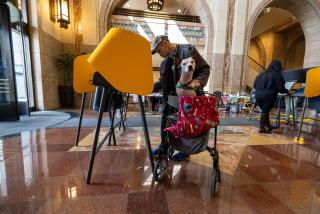A Bigger City Council for Better L.A. Governance
- Share via
Although Los Angeles has many natural assets that make it a pleasant place in which to live, signs are appearing that indicate dissatisfaction with the way the city is governed. Consider what has transpired in recent weeks.
The Mexican American Legal Defense Fund has joined a U.S. Justice Department lawsuit calling the current Los Angeles City Council boundaries discriminatory, and has asked for a redrawing of the districts to increase the possibility of electing more Latinos.
Prompted by mounting citizen concern over unchecked commercial development near residential neighborhoods, two council members from the West Side, Zev Yaroslavsky and Marvin Braude, and the head of the city planning commission, Dan Garcia, have launched an initiative campaign to reduce drastically the allowable density of future commercial projects in most parts of the city. A citizens group called “Not Yet New York” is considering its own growth-control initiative.
Upset over the design and scale of new downtown high rises, a group of leading Los Angeles architects and planners has held public meetings to discuss the lack of “people-oriented” urban design, and has called for the hiring of a new city planning director who is sensitive to the group’s concerns and to the impact of development on the city’s neighborhoods.
Such dissatisfaction is not surprising. What is surprising is that such sentiments have taken so long to surface.
For years, Los Angeles has suffered from a lack of citizen participation in the city government, especially in the planning process. While the current burst of activism is welcome, it still does not address the heart of the matter--namely that the structure of city government could dramatically be made more democratic.
Although the City Council, acting to head off a federal trial over discrimination, has announced that it will redraw the existing council districts, such redistricting is not the best answer to Latinos’ concerns nor to the needs of the city. City government in Los Angeles is too distant from all of the citizenry, not just minorities.
Democratic representation has not kept pace with city population. Each of the 15 council members represents more than 200,000 people. Comparatively, Chicago has 50 council members and New York has 43. Los Angeles’ huge council districts mean that officials represent widely disparate neighborhoods. Councilwoman Pat Russell, for example, speaks for such diverse areas as Venice, Westchester and Crenshaw.
The number of council districts should be tripled to 45. And those districts should, as much as possible, be drawn to cover distinct neighborhoods. This reform would make it more likely that minority representation on the council would increase, while in turn making the council more responsive to the city’s neighborhoods. Such smaller, more neighborhood-oriented districts would also reduce the influence of monied special interests, especially developers, by encouraging candidates to run grass-roots, door-to-door campaigns.
Regarding development issues, the planning department in the past has done little to deal with the adverse effects of over-development in some neighborhoods and underdevelopment in others. What is needed is not simply down-zoning as proposed by Yaroslavsky, Braude and Garcia, but the creation--by ordinance or initiative--of intermediate planning structures, such as New York’s community planning boards or St. Paul’s district councils. These officially recognized bodies have their own staff and a legal right to participate in city planning decisions. Such neighborhood planning boards should be established in each of the expanded number of council districts and provided with office space and funds.
In addition the city government should recognize its responsibility to support democratic citizen participation by establishing an office of neighborhood associations. If modeled after the one in Portland, this permanent city office would provide technical and financial assistance to democratically constituted neighborhood organizations to assist them in producing newsletters, organizing block clubs and initiating neighborhood projects. By providing information and resources to neighborhood groups, the city would ensure that its residents have the opportunity and the means to express themselves on issues that affect their lives, as well as support for volunteer action to improve their own neighborhoods.
These three structural reforms--neighborhood-based council districts, neighborhood planning boards and an office of neighborhood associations--could be drawn together as a single charter amendment, perhaps titled the Neighborhood Democracy Initiative, and put before the citizens for a vote in November. Such democratizing reforms as these would bring city government closer to citizens and help to ensure that the future development of Los Angeles is decided as democratically as possible.
More to Read
Sign up for Essential California
The most important California stories and recommendations in your inbox every morning.
You may occasionally receive promotional content from the Los Angeles Times.










